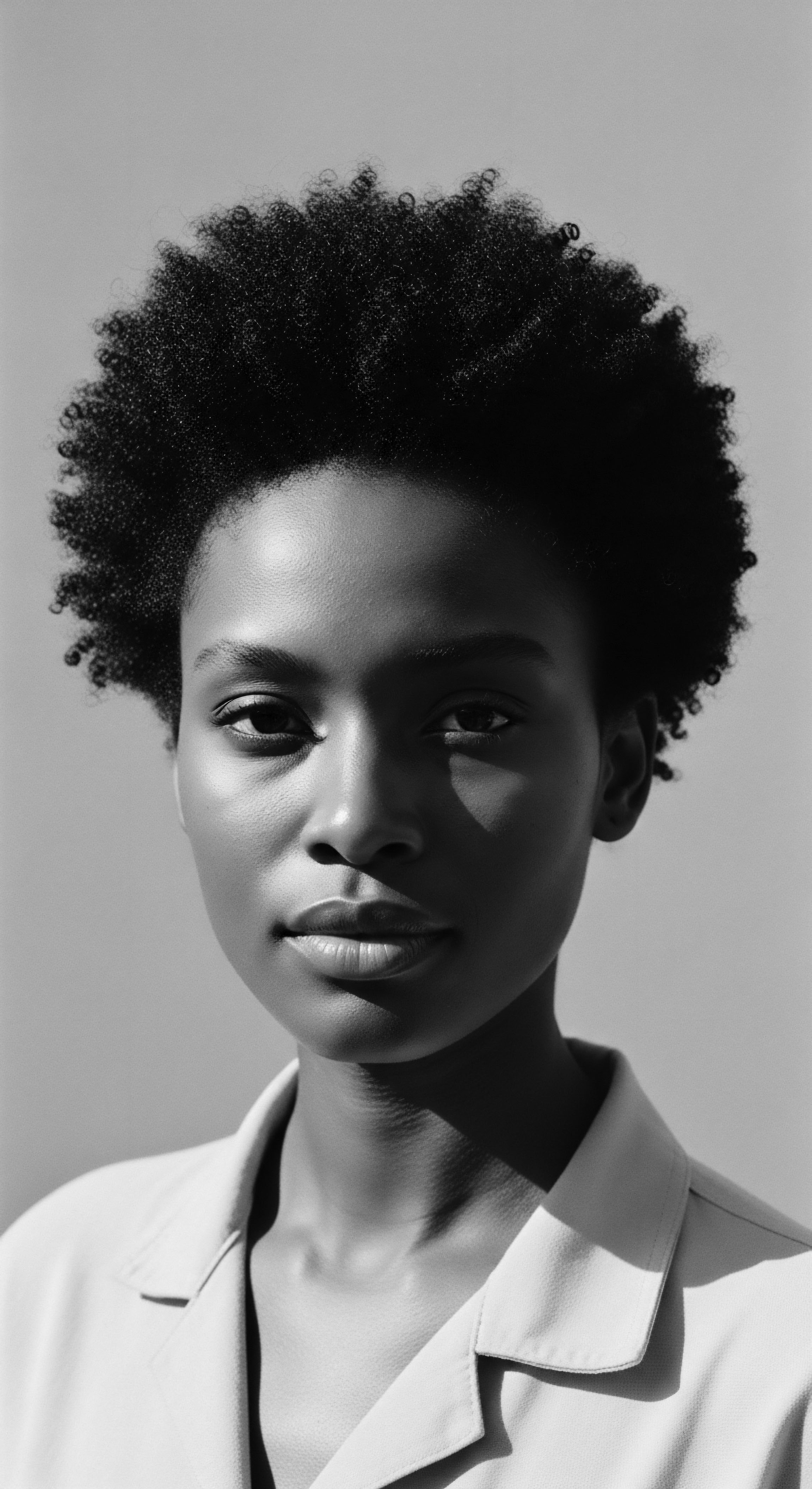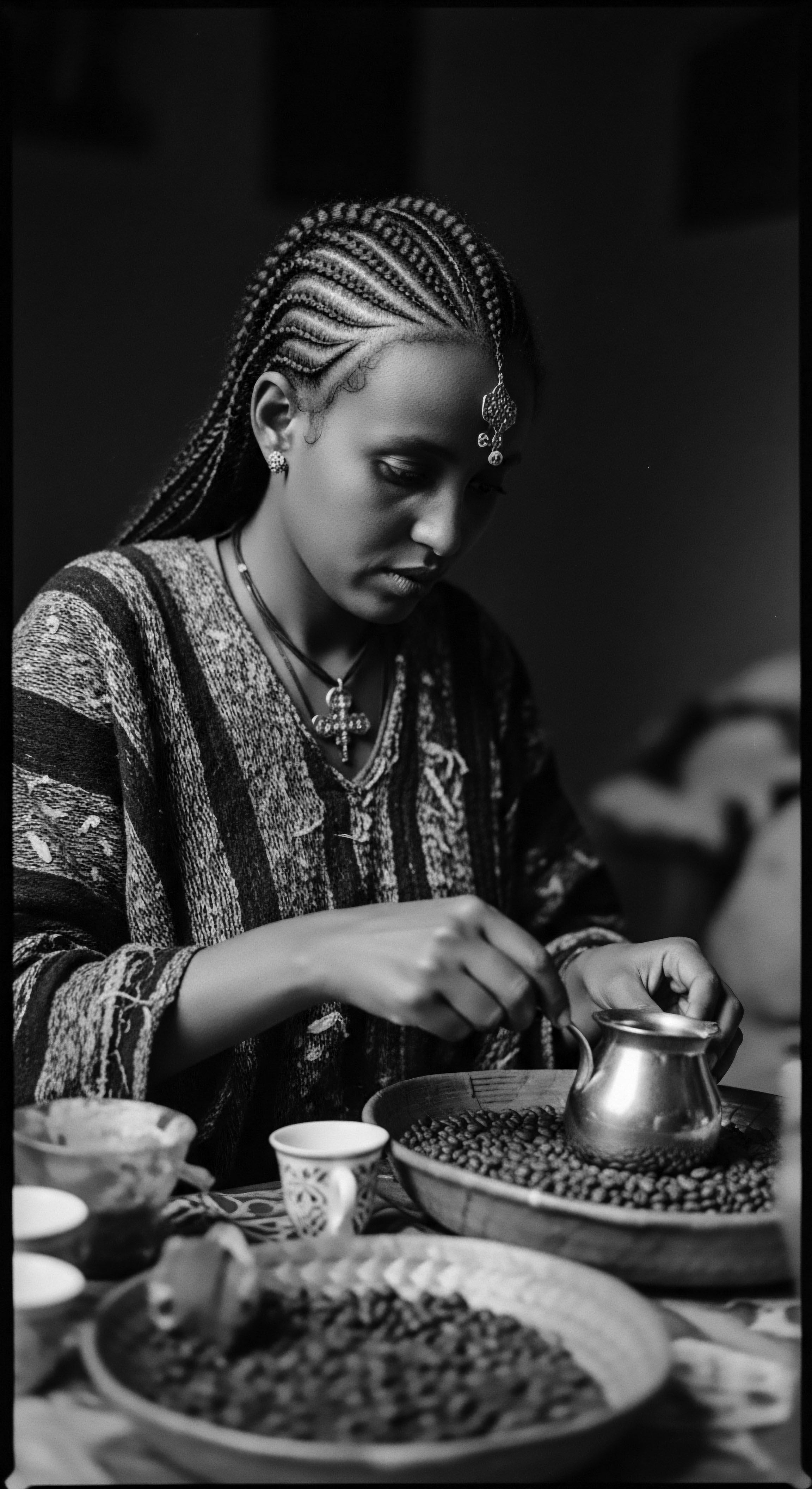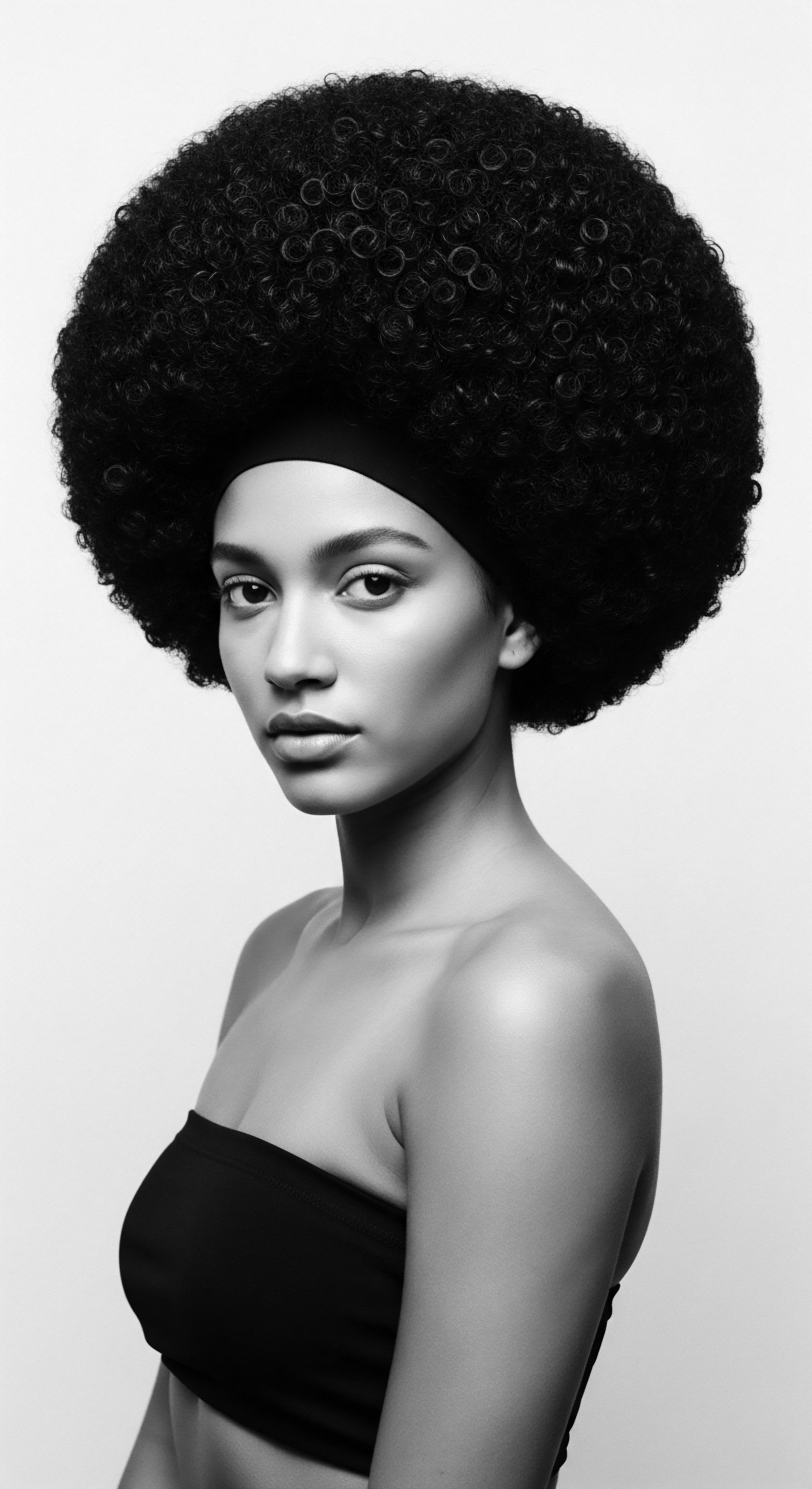
Roots
The very strands of textured hair carry whispers of ages past, an enduring legacy etched into each coil and curl. For those who bear this crown, hair is more than simply a biological outgrowth; it stands as a living archive, a constant, tangible link to ancestral identity and community. This connection, deeply embedded in the historical and scientific heritage of textured hair, guides us. It is a story not solely of biology, but of profound cultural continuity and resilience, a testament to the spirited journey of Black and mixed-race peoples across time and continents.
Consider the initial question ❉ how does textured hair connect to ancestral identity and community? The answer unfolds in layers, beginning with the very structure of the hair itself, then extending through the languages and practices that have always honored it.

Hair’s Elemental Blueprint ❉ Ancestral and Modern Understanding
At its fundamental level, textured hair possesses distinct anatomical and physiological characteristics. The elliptical cross-section of the hair shaft, a trait seen in hair of African descent, causes the strand to curl as it grows. This shape, alongside the distribution of keratin proteins and the way the cuticle layers lay, creates the varied patterns we observe, from broad waves to tight z-patterns (Byrd & Tharps, 2014). This unique morphology is not a flaw, but a biological marvel, an adaptation sculpted over millennia.
Ancient communities, though lacking modern microscopes, recognized these inherent qualities. Their understanding was experiential, rooted in observation and the wisdom passed through generations. They understood how humidity affected curl, how certain oils sealed in moisture, and how specific styles protected the delicate coils. These were not mere cosmetic observations; they reflected a deep, intuitive science of hair, informed by the environment and collective knowledge.

The Language of Curl ❉ Classifications and Their Cultural Echoes
Contemporary systems for classifying textured hair, such as the widely adopted Andre Walker Hair Typing System, categorize strands from straight (Type 1) to coily (Type 4), with sub-types (A, B, C) indicating curl tightness. While these systems aim to aid product selection and styling, their origins are worth examining through a heritage lens. One early 20th-century hair typing system, for instance, was devised by Eugen Fischer, a German Nazi ‘scientist’ in 1908, who used hair texture to determine a person’s proximity to whiteness, particularly regarding Namibians. This unsettling past reveals how systems meant to categorize have sometimes been wielded to support racist ideologies, imposing hierarchies upon inherent physical traits.
Yet, pre-colonial African societies possessed their own intricate, dynamic classifications. These were not rigid categorizations based on European beauty standards, but rather on social meaning and symbolism. Hair spoke a language of its own, signifying age, marital status, tribal affiliation, wealth, and spiritual beliefs. A hairstyle could announce one’s readiness for marriage, a period of mourning, or a warrior status.
For instance, in the Wolof tribe of modern Senegal and The Gambia, young women might shave a portion of their hair to signify their single status (Tharps, 2001). This rich lexicon, embedded in practice and adornment, serves as a testament to the hair’s communicative power within its original contexts.
Textured hair, with its unique biological structure, serves as a profound, living chronicle, connecting individuals to their ancestral lineage and community practices.

What Did Traditional Hair Terms Signify?
The vocabulary surrounding hair in African cultures was rich and descriptive, reflecting its importance. Beyond simple descriptors of curl or coil, terms often carried deeper social or spiritual meanings. These terms often related to:
- Social Status ❉ Certain styles or adornments were reserved for royalty, elders, or those of particular standing.
- Life Stages ❉ Hairstyles changed with rites of passage, marking transitions from childhood to adulthood, marriage, or motherhood.
- Tribal Identity ❉ Distinct patterns and methods identified one’s specific community or familial group.
- Spiritual Connection ❉ Hair was considered a conduit to the divine, often styled in ways to invite blessings or ward off malevolent forces.

The Rhythmic Cycles ❉ Growth and Ancestral Wisdom
The rhythm of hair growth, from its active anagen phase to its resting telogen phase, is a universal biological truth. However, factors influencing this cycle – nutrition, environment, stress – were deeply understood by ancestral communities. Traditional diets, rich in locally sourced nutrients, supported healthy hair. Practices like scalp massages with natural oils, not only for beauty but for stimulating growth and circulation, highlight an intuitive understanding of hair biology.
Before the transatlantic slave trade, Africans utilized a variety of natural ingredients to maintain hair health. Shea butter, marula oil, African black soap, and chebe powder are but a few examples, passed down through generations. These elements, derived from the earth around them, were integral to regimens that prized moisture retention and protection against environmental factors. This continuity of wisdom, linking elemental biology to generational practices, grounds the understanding of textured hair in its heritage.

Ritual
From the foundational roots of hair itself, we move to the living traditions, the tender actions that have sculpted and cared for textured hair through epochs. Ritual, in this context, reaches beyond simple habit; it signifies a deliberate, often communal, act imbued with meaning and history. The art and science of textured hair styling, viewed through this heritage lens, reveals how ancestral practices are not relics of the past, but vibrant, continuing expressions of identity and belonging. These styles, techniques, and tools form a delicate yet resilient thread that binds generations.

The Sacred Geometry of Protective Styles ❉ Ancient Origins
Protective styling, now a widely adopted practice for maintaining hair health, holds deep ancestral roots. Its origins span millennia, serving purposes far exceeding mere aesthetics. These styles, such as braids, twists, and locs, were meticulously crafted to guard hair from environmental damage, minimize manipulation, and preserve length.
Archaeological evidence and historical records confirm the widespread use of these techniques across ancient African civilizations. For example, cornrows, with their precise, raised rows against the scalp, date back as far as 3500 BC in African culture, where they served as a form of communication, indicating tribal identity, age, marital status, or social status.
During the horrific period of the transatlantic slave trade, the significance of protective styles deepened profoundly. Stripped of their names, languages, and cultural markers, enslaved Africans often had their heads shaved upon arrival, a brutal act designed to erase identity and connection to homeland. Yet, resilience persisted.
Enslaved women ingeniously braided rice seeds into their hair for survival during voyages and used intricate cornrow patterns as coded maps for escape routes. This adaptation of a traditional practice into a tool of resistance offers a poignant testament to the enduring power of hair as a cultural repository.
| Traditional Style/Concept Cornrows |
| Historical Significance and Ancestral Context Ancient African origins (3500 BC). Used to convey tribal identity, age, status, and even serve as escape route maps during enslavement. |
| Modern Manifestation and Connection Continues as a foundational protective style, appreciated for its neatness and versatility, often seen in varied geometric patterns. |
| Traditional Style/Concept Bantu Knots |
| Historical Significance and Ancestral Context Originated with the Zulu people of Southern Africa. Elevated knots were considered spiritual. |
| Modern Manifestation and Connection Popular modern protective style for curl definition and heatless stretching, valued for its protective qualities. |
| Traditional Style/Concept Locs (Dreadlocks) |
| Historical Significance and Ancestral Context Ancient African origins, sported by Ethiopian Coptic Orthodox Church priests as early as 500 BCE, signifying spiritual devotion. |
| Modern Manifestation and Connection A profound expression of cultural identity and spirituality, requiring minimal manipulation once established. |
| Traditional Style/Concept These styles demonstrate a living cultural heritage, adapting through time while retaining core protective and symbolic functions. |

Natural Styling ❉ Echoes of Traditional Definition
The pursuit of natural hair definition, so prevalent today, echoes traditional methods of enhancing and maintaining textured hair’s inherent beauty. Long before commercial products, ancestral communities mastered techniques to cleanse, moisturize, and shape their coils and curls using natural resources. These were not simply about achieving a certain look; they were about cultivating healthy hair, often tied to rituals of self-care and community bonding.
Traditional methods included the use of natural oils such as shea butter, coconut oil, and argan oil for moisturizing and sealing. African hair threading, known as “Irun Kiko” among the Yoruba people of Nigeria since the 15th century, served to stretch and retain hair length without heat, protecting it from breakage. These practices highlight an early understanding of hair manipulation that respected and worked with the hair’s natural inclinations.

Hair Adornment ❉ Symbols and Stories
Beyond the shaping of hair itself, the adornment of textured hair tells its own compelling story of heritage. Beads, cowrie shells, and precious metals were not merely decorative; they held profound symbolic meaning, often denoting wealth, status, marital readiness, or connection to ancestry. In ancient Egypt, elaborate wigs adorned with gold and beads symbolized wealth, religious devotion, and connection to deities. In Nigeria, Igbo women used to adorn their hair with glass beads called jigida, which were considered symbols of good luck and fertility, especially during wedding ceremonies.
The intricate artistry of textured hair styling acts as a living archive, communicating identity and safeguarding the hair’s integrity across generations.
These adornments, from the simple and functional to the highly ornate, served as a visual language within communities. They allowed individuals to carry their history, their status, and their aspirations openly, literally threaded into their crowns. This practice continues today, with many embracing traditional hair adornments as a way to honor their ancestry and express their personal style.

Relay
As the past gently guides the present, the dialogue between ancient practices and contemporary understanding of textured hair grows ever richer. This ongoing exchange, a relay of wisdom across time, elevates our appreciation for how textured hair connects to ancestral identity and community. It speaks to hair as a canvas for self-expression, a banner of cultural belonging, and a powerful symbol in shaping collective futures. The scientific lens often validates ancestral insights, while heritage provides the profound context that makes modern care truly meaningful.

Why is Ancestral Wisdom Important in Modern Hair Regimens?
Building a personalized textured hair regimen today gains significant strength and depth from ancestral wisdom. Modern science has begun to affirm what traditional healers and stylists knew intuitively for centuries ❉ certain natural ingredients and gentle practices provide optimal conditions for hair health. For instance, the widespread use of oils and butters like shea butter and coconut oil in traditional African hair care, aimed at moisture retention, aligns with current scientific understanding of textured hair’s need for emollients to counter dryness. These practices offer a counter-narrative to historical pressures that often promoted harsh chemical straightening (Byrd & Tharps, 2014; Dabiri, 2020).
The contemporary natural hair movement, which gained significant traction in the 2000s, actively seeks to reclaim and popularize natural styles, challenging Eurocentric beauty standards. This movement is deeply rooted in ancestral principles of self-acceptance and the celebration of hair’s inherent qualities. It encourages individuals to move away from damaging practices and towards regimens that honor their hair’s natural texture, a direct lineage to the holistic care systems of the past.

The Nighttime Sanctuary ❉ Heritage and Protection
The nighttime care of textured hair, particularly the ritual use of head coverings like bonnets and wraps, represents a direct continuation of ancestral practices. Historically, headwraps were integral to African societies, signifying wealth, ethnicity, marital status, or even emotional state. Beyond their communicative function, these coverings provided essential protection against the elements.
During enslavement, headwraps and bonnets, initially used by European women for warmth and to keep hair neat, were tragically weaponized to mark and subjugate Black women. Despite this oppressive context, Black women transformed these coverings into symbols of resilience and creative expression, choosing beautiful fabrics and adorning them. They also served a practical purpose ❉ preserving hairstyles and protecting delicate strands from breakage and moisture loss during sleep.
This dual role of protection and self-affirmation persists today. Bonnets, often made of satin or silk, reduce friction against pillows, preventing tangles, frizz, and moisture depletion.
The persistent use of head coverings for textured hair embodies a powerful legacy of protection and cultural defiance, stretching back through generations.
This tradition is a profound example of how seemingly simple accessories carry layers of historical meaning, connecting daily routines to a deep collective memory of survival and self-preservation.

Ingredient Wisdom ❉ Validating Traditional Remedies
The ancestral knowledge of natural ingredients for hair care finds strong support in modern scientific analysis. Many traditional African ingredients possess properties that modern cosmetologists recognize as beneficial for textured hair.
- Shea Butter ❉ Derived from the nuts of the shea tree, shea butter is rich in vitamins A and E and essential fatty acids. It provides deep moisture, promotes elasticity, and offers protective qualities, making it ideal for sealing in hydration for coily hair.
- African Black Soap ❉ Traditionally crafted from plantain skins, cocoa pods, and palm oil, this cleanser is known for its ability to purify without stripping natural oils, offering a gentle yet effective wash.
- Marula Oil ❉ This traditional oil from Mozambique and South Africa is packed with oleic acid and antioxidants, providing moisture and helping with scalp conditions.
- Chebe Powder ❉ Sourced from Chad, this blend of seeds and herbs (like lavender crotons and cloves) is mixed into a paste, historically used to strengthen hair, reduce breakage, and thereby promote length retention.
These traditional remedies, passed down through oral traditions and communal practice, represent a sophisticated understanding of botanical properties. They speak to a time when care was directly linked to the earth, when remedies were sourced from the immediate environment, reinforcing the symbiotic relationship between humans, nature, and cultural practice.

Connecting with Ancestors through Adornment and Ritual
The connection between textured hair and ancestral identity also manifests through the spiritual dimensions of hair care. In many African cultures, hair was considered the highest point of the body, a conduit to the divine and a locus for one’s spirit. Rituals involving hair, whether for naming ceremonies, rites of passage, or mourning, often served to honor ancestors and communicate with the spiritual realm.
A powerful example of this spiritual link is found among the Mursi people of Ethiopia, where hair braiding is part of funeral rituals, symbolizing a direct connection with the deceased. Similarly, the practice of adorning hair with specific beads or amulets was believed to offer spiritual protection or bring blessings. This heritage underscores that hair care is not a superficial act; it is a sacred ritual, a way to maintain continuity with those who came before, embodying their wisdom and carrying their spirit forward.

Reflection
The journey through textured hair, from its elemental biology to its profound cultural and communal resonance, affirms its standing as a living, breathing archive. Each coil and curl holds within it stories of adaptation, artistry, survival, and celebration. This exploration, deeply infused with the ‘Soul of a Strand’ ethos, reveals hair as a dynamic legacy, forever linking us to ancestral identity and community. It is a reminder that heritage is not static, but a vital, moving current, shaping expressions of self and belonging.
In the intricate patterns of a braid, the nourishing touch of a traditional oil, or the proud wearing of an Afro, we find not just aesthetic choices, but powerful affirmations of who we are and from where we come. This ongoing dialogue with the past allows textured hair to remain an enduring symbol of resilience and a source of profound connection.

References
- Byrd, A. D. & Tharps, L. L. (2014). Hair Story ❉ Untangling the Roots of Black Hair in America. St. Martin’s Press.
- Dabiri, E. (2020). Twisted ❉ The Tangled History of Black Hair Culture. Harper Perennial.
- Rosado, S. (2003). Styling Blackness ❉ The Black Hair Culture. University of Illinois at Chicago. (Doctoral Dissertation)
- Sherrow, V. (2006). Encyclopedia of Hair ❉ A Cultural History. Greenwood Publishing Group.
- Tharps, L. L. (2001). Hair Story ❉ Untangling the Roots of Black Hair in America. (This citation points to the earlier edition cited in search result, used for the Wolof example).
